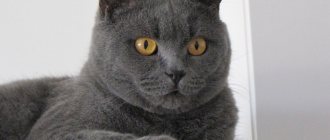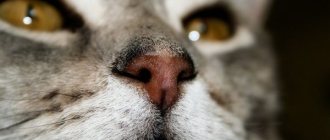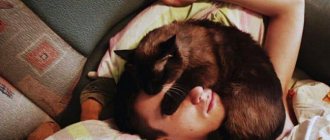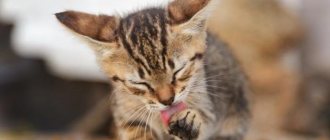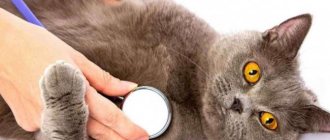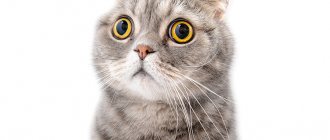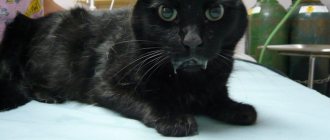All animals, falling asleep, relax and begin to make various sounds. Therefore, it is not surprising that a cat snores in its sleep. The main thing is to determine whether it is snoring. Such sounds can be a kind of purring or loud snoring. If it really is snoring, then you need to find the cause of its occurrence. It can appear due to the development of pathologies or pronounced characteristics of the cat’s breed.
Treatment
The method of treating an animal should only be prescribed by a veterinarian after a diagnostic examination. Based on its results, various therapeutic measures can be prescribed, for example:
- If a cat snores and wheezes in his sleep, and he is overweight, then the owner should think about organizing proper nutrition for him. The diet should include special dietary foods or low-calorie cereals. You also need to take care of the amount of food. The animal needs to be fed in small portions, but every 4-5 hours.
- If a pathology such as hyperplasia of the soft palate is detected, surgery to remove it is prescribed.
- Treatment of respiratory diseases takes the longest: asthma and bronchitis. In this case, the cat will need daily injections, decongestants or aerosols. The type of drug treatment and the method of introducing it into the body depends only on the stage of the pet’s disease.
- If the cause of snoring is an allergic reaction, then the cat is given a special drug that suppresses the effects of the allergen.
Possible diseases
If a cat snores in his sleep, this can be a symptom of the development of various diseases, for example:
- Swelling of the larynx due to exposure to an allergen on this organ.
- Asthma. With the development of this disease, snoring always appears. It is accompanied by a number of other symptoms: obsessive cough, rapid breathing.
- Disease of the genitourinary system. As it develops, the owner may notice bloody discharge in the pet’s urine and the appearance of pain during each trip to the toilet, which can be noticed by the cat’s behavior.
- Bronchitis. Just like in an adult, this disease is accompanied not only by snoring, but also by constant coughing, sneezing, difficulty breathing and moist wheezing, even while awake.
- Disorders of the heart (heart failure), due to accompanying symptoms, this disease can be confused with bronchitis.
- Excess weight, which increases the load on the heart and, accordingly, snoring appears.
You can find out exactly why a cat snores in its sleep by doing a diagnostic examination. To do this, you need to visit or call a specialist at home.
Causes of snoring
There are several factors that cause sleep problems in cats. This is a genetic predisposition and physiological deviations in the health of the animal. For some cat breeds, snoring is considered normal. This is due to the fact that the sinuses of these cats are too short. This phenomenon is called brachycephalic syndrome. Persians, British, Scottish and exotic cats are susceptible to it. The shape of the skull in these breeds is completely round, and the muzzle is flattened and short.
If your Scottish or British cat begins to snore heavily, breathe heavily and suffocate, you should consult a veterinarian as soon as possible. Most often, in such cases, surgical intervention is resorted to. Sometimes a sleeping cat makes sounds that have not been observed before
It is important for the owner to monitor the pet and visit the clinic in the following situations:
When adding sneezing to a symptom, you should not ignore the animal’s condition.
- snoring started recently or was less severe;
- the cat snores loudly;
- breathes heavily and opens his mouth;
- sneezes and coughs;
- whistles and grunts.
The causes of snoring and such sounds may be the following pathologies:
- Colds, bronchitis, pneumonia. Accompanied by discharge of purulent mucus from the nose, a cough appears, leading to vomiting.
- Heart failure.
- Injuries. The increased activity of cats leads to bruises, concussions, and rib fractures.
- Swelling of the larynx. Occurs when allergic reactions to any food or chemical reagents.
- Obesity. Excess weight puts a huge strain on the heart muscle.
- Helminths. Parasites can be found not only in the gastrointestinal tract, but also in the respiratory tract.
- Foreign body. When playing, a small object may get into the throat or nasopharynx, making breathing difficult. The cause could also be a stuck bone or piece of food.
Types of snoring
Swelling of the airways is manifested by specific whistling sounds.
By the sounds that a British cat or animal of another breed makes when sleeping, you can determine the disease
Therefore, when visiting a veterinary clinic, it is important for the owner to describe in detail to the veterinarian the nature of the cough and snoring, as well as tell him exactly how the cat breathes. There are 4 types of snoring:
- Dry. It can be heard when exhaling and gives the impression that the pet is wheezing. Occurs when the trachea and bronchi are significantly narrowed.
- Wet. Heard when inhaling and exhaling. Accompanied by the sounds of bursting bubbles.
- Inspiratory. The animal makes sounds similar to whistling or hissing. Occurs when the airways become swollen.
- Creptifying. Appears when exhaling. Similar to the sound of dry crackling. The reason is the straightening of the stuck together alveoli.
Comprehensive diagnostics
Cat owners should remember that any pathology has several manifestations at once, which make it possible to more accurately determine the disease. If you don't notice any changes in your pet other than snoring, there is most likely no cause for concern. Of course, an extra trip to the vet is never harmful.
However, cats whose snoring is accompanied by other negative symptoms that are not immediately noticeable and sometimes almost completely unnoticeable deserve special attention. Less obvious manifestations of a possible disease include:
- General weakness, apathy;
- Lack of appetite;
- Temperature increase;
- Digestive disorders: diarrhea, diarrhea, constipation;
- Shortness of breath during free time from sleep, difficulty breathing;
- Frequent sneezing;
- Cough.
Taking an anamnesis
If you have checked one or more items from the above list, you should collect a preliminary medical history to prepare for the veterinarian’s upcoming questions. The anamnesis includes the following information:
- Age and basic habits;
- Accurate weight;
- The time of occurrence of snoring and the possible reasons with which the owner associates it;
- The specificity of the extraneous sounds causing concern - whether they are heard during inhalation, exhalation, or both;
- Paleness or, conversely, inflammation of the mucous membranes during sleep or immediately after waking up;
- The presence of traumatic brain injuries or injuries that affected the muzzle or some parts of it;
- The manifestation of indirect symptoms indicating the painful condition of the pet, indicated above.
Where does a cat run in a dream?
The reasons for sleepy “escapes” must be sought in the characteristics of the mammalian brain, more precisely, in the phases of sleep.
When our cat sleeps, his brain does not completely turn off; he diligently sorts all the previously received information, as they say, into shelves. During sleep, a cat’s body is practically motionless, it does not repeat the movements that it dreams of, the brain turns off this function of “conscious movement”. This stage is conventionally called “drowsiness”.
At this stage, the cat can still wake up easily, the muscles are not completely relaxed, the eyes can be half-closed and move slowly.
In the second phase, the cat’s muscles relax completely, breathing and pulse slow down, communication with the outside world disappears, the eyeballs stop moving, rolling under the eye sockets. But a cat can still be easily awakened by a loud, unexpected sound. It is interesting that the brain and with it the muscles will work faster than consciousness will “turn on”. Having jumped up, the cat will rush to run away, not realizing what happened and not being aware of its movements.
Such behavior often makes people laugh and they provoke such situations. This is cruel to an innocent animal. Moreover, a cat, and especially a kitten, can be seriously injured by hitting its head “from sleep” or catching its claw on a carpet or something similar.
The third stage of cat sleep is a transition between REM and deep sleep.
.
The sleep is deep and calm, the brain is practically turned off, there is no muscle tone, the eyes are motionless, the boundary between sleep and reality is completely blurred. It is during this period that our feline “princes” and “queens” begin to actively snore! They don’t dream anything, their brain is “asleep.” The brain sleeps, the kitty snores, and we are touched by the snoring animals!
Features of the next two stages are the activity of cats during sleep.
It's all about the increasing activity of the cat's brain. “Ability to sleep and dream!” No one has this skill better than cats! They not only see dreams, they also actively participate in them! Does a cat catch a mouse in dreams? – The cat scratches the rug on which it sleeps. Did the kitten see a scratching cat in a dream? – He will “run” away from her at full speed, twitching his paws funny. He dreamed of his mother cat and again, as in infancy, he drinks milk from her? – Involuntarily, the baby will begin to suck his paw.
Signs of the painful nature of snoring
The following factors increase the risk of developing pathologies that cause snoring:
- age – over 5 years;
- metabolic problems (mainly obesity);
- low physical activity.
It is important to pay attention to some points - the veterinarian will ask about them:
- How long has it been since your cat started snoring?
- When is it heard (during exhalation or inhalation)?
- Have your mucous membranes turned pale?
- Has the cat been injured?
Symptoms indicating the development of a disease are as follows:
- weakness;
- vomit;
- diarrhea;
- cough;
- apathy;
- nervousness;
- labored breathing.
For example, wet wheezing when inhaling indicates problems with the lungs. Dry, on the other hand, signals swelling of the upper tract.
As previously noted, in some cases, snoring is not a sign of a serious health problem. But only a visit to the clinic will make sure that your worries are in vain.
During the examination, hyperplasia is often detected in animals. This is what doctors call a thickened soft palate. If this does not cause any significant inconvenience to the cat, treatment is not particularly necessary. Otherwise, the problem is corrected surgically.
At the same time, snoring is often caused by the following diseases:
- asthma;
- swelling of the larynx;
- helminth infection;
- urolithiasis disease;
- bronchitis;
- pneumonia;
- heart failure;
- and finally obesity.
For example, swelling is in most cases a sign of allergies. Identifying the irritant and taking antihistamines will help eliminate snoring.
Asthma is always accompanied by very characteristic attacks of suffocation. They are observed both during sleep and during wakefulness.
With urolithiasis, wheezing is caused by pain and intoxication. The thing is that accumulating sand sometimes closes the urinary canal. Stagnation of urine leads to frequent inflammations, which cause more suffering.
Both pneumonia and bronchitis have quite obvious accompanying symptoms:
- temperature;
- snot;
- cough;
- wheezing, whistling when breathing.
The British cat has a hereditary tendency to such diseases.
If a cat has developed heart failure, he will wheeze both when inhaling and exhaling. The diagnosis is made on the basis of an ECG.
In all cases, self-medication is extremely dangerous, because without knowing the exact diagnosis, you can only worsen the pet’s situation.
Possible diseases and pathologies
When your pet snores constantly, or very often, it may be a symptom of one of the following conditions:
- swelling of the larynx; may be caused by allergies, or the presence of foreign objects in the respiratory system;
- ; snoring is sometimes accompanied by wheezing;
- the presence of worms, which may even be present in the respiratory system;
- asthma;
- pneumonia and bronchitis;
- heart failure; along with wheezing, a cough and blue discoloration of the mucous membranes can be observed;
- respiratory tract infections;
- obesity.
A veterinarian will help the owner determine the cause of wheezing when breathing in a cat.
Preventive actions
To prevent the listed diseases, one of the symptoms of which is sniffling and grunting in a pet, the following safety measures must be observed:
- Carry out vaccinations and deworming in a timely manner. Such measures will help avoid the development of infectious diseases and the appearance of parasites.
- If your pet has an allergy, eliminate its sources in the apartment and avoid the cat’s contact with allergens outside the home.
- Avoid overeating. Do not leave uneaten food in the bowl. If you gain excess weight, it is recommended to switch your pet to a low-calorie diet. Sterilized cats and neutered cats must be fed special food.
- Avoid hypothermia and overheating of the pet and drafts.
- Increase the animal’s immunity through the regular use of vitamin and mineral complexes, agreed with the veterinarian.
- Conduct regular preventive veterinary examinations to promptly identify existing diseases.
- Start eliminating signs of pathologies immediately after they are identified.
Helminthiasis
An animal carrying parasitic worms can make unusual grunting sounds.
Toxocara. The development cycle of the Toxocara nematode begins with the cat swallowing food infested with larvae or eating the intermediate host of the parasite, which is:
Development in the body. In the intestine, the larva actively invades the blood vessel through the epithelial wall in order to enter the lungs with the bloodstream. Young parasites feed on the blood and tissues of the airways, causing severe irritation, difficult wheezing breathing and a reflex cough.
The damaging effect leads to the attachment of pathogenic bacteria that increase inflammation. With a cough, some of the larvae enter the oral cavity and are swallowed again, growing in the intestines into a mature worm. During the period of migration of larvae into the digestive tract, the cat may experience the urge to vomit.
Hookworm. Hookworm larvae cause hookworm disease by entering the cat’s body in several ways:
- simultaneously with food and water;
- when self-licking;
- through the skin with subsequent penetration into the bloodstream;
- when eating infected rodents.
Development. The path of larvae that have penetrated through the skin into the blood lies in the respiratory tract, and then, when coughing, into the oral cavity.
After 3 weeks, swallowed parasite embryos grow in the intestines into adult individuals that feed on the blood of the host animal.
Clinical picture of helminthic infestation. Infection with helminths in a cat is indicated by:
- poor appetite and weight loss;
- apathetic behavior;
- disruptions in the gastrointestinal tract;
- increase in abdominal volume;
- the appearance of mucus and blood in feces;
- unkempt appearance, poor coat;
- constant discharge from the eyes;
- pallor of the mucous membranes in the mouth.
Diagnosis and treatment. The diagnosis is based on laboratory tests of blood and feces. Having determined the type of helminth, anthelmintic drugs are prescribed in the required dose and, possibly, with repeated use.
Also watch the video of a cat breathing with wheezing:
Why is the cat snoring?
The respiratory system of cats is similar to humans. Our pets can sigh, sniffle and even snore in the same way. Most often this happens in a dream. Dreams of cats can consist of various events that cause an external reaction not only in the form of twitching their paws, as if the animal is running, shuddering, but also reactions of the respiratory system.
But if a cat or kitten sniffles not only during sleep, but also when awake, this may indicate the appearance of health problems. In this case, the owners need to more carefully observe the pet, which sniffles when it breathes, and track the duration and frequency of the snoring. This can help in determining the cause of the condition, and in deciding what to do and how to treat the animal.
The most common causes of cat snoring
:
Periodic snoring is normal for humans and animals. If this happens rarely, it should not be a cause for concern. But if it's a cat sniffling while breathing all the time, or even breathing with its mouth open, it should be a cause for concern. Persistent breathing problems can lead to more serious health problems. Most likely, you will need a veterinarian's consultation and treatment, because... It is difficult or even impossible to independently determine the disease. But before contacting a doctor, it is necessary to observe an animal that is sniffling and breathing heavily. To make a diagnosis, exclude various diseases and prescribe the correct treatment, the doctor will need detailed information.
The veterinarian may ask for the following information about a cat who wheezes when he breathes:
:
- the age of the animal and its lifestyle;
- weight and its relationship with the norm for a given breed;
- how long ago did the wheezing occur?
- Are there other sounds heard when the cat breathes?
- changes in the color of mucous membranes;
- the presence of various injuries (torso, nose, mouth, larynx);
- changes in behavior (low activity, weakness, excitability);
- other symptoms (digestive problems, vomiting, other breathing problems, cough, runny nose, sneezing).
If your cat is breathing poorly through his nose and sniffling, you should not wait for this to go away on its own. Such signs may indicate a serious illness in a cat or kitten that requires immediate treatment.
The nature of the snoring and sounds can often roughly determine the source of the disease.
:
- wet rales indicate the presence of phlegm in the respiratory organs;
- dry wheezing indicates the presence of swelling in the bronchi or throat;
- crackling – there may be problems in the alveoli;
- A whistling sound may indicate swelling in the respiratory tract.
Only timely initiation of treatment and the correct choice of medications can ensure a quick and complete recovery of the pet. You should not rely on the recommendations of other cat owners from forums - each case is individual, even with similar symptoms.
It might be useful to read:
- Causes and treatment of uterine subinvolution after childbirth;
- Online test “What kind of cat are you? Test how much of a cat you are;
- We take an Igm immunoglobulin test; what kind of test is it?
- “For health you need cold and movement”;
- Peony officinalis Peony flowers in folk medicine;
- Headache and pressure on eyes - what to do? ;
- Healing properties, uses and contraindications of peony petals Peony flowers medicinal properties;
- Blood after constipation Frequent constipation; bloody stool;
Negative associated symptoms
If your cat snores, you should carefully monitor his health. If this phenomenon is accompanied by other accompanying symptoms, then you need to consult a doctor immediately. These include:
- increased body temperature;
- general deterioration in health: lack of appetite, constant drowsiness;
- changes in stool consistency - diarrhea;
- prolonged absence of stool - more than 2 days;
- difficulty or rapid breathing;
- cough;
- frequent sneezing;
- continuation of wheezing even while awake.
You should be wary if your cat's health worsens. His life may be at risk; specialist help and drug therapy are needed immediately.
When it's not snoring at all...
Sometimes owners confuse snoring with rumbling. Half-asleep cats quietly turn on the purr. Listen better!
And sometimes cats have dreams during which they behave excitedly, virtually catching prey or running away from pursuit. At this moment, the cat can also make various interesting sounds and even make movements. But if such dreams haunt your pet every night, while he tosses and turns nervously and makes loud noises, this indicates an overexcited nervous system. This condition requires treatment.
Author of the article Ekaterina Yugosh
– editor of the “Murkotiki” website, a journalist with a felinological education (a felinologist is a specialist who studies cats). She received her felinological education according to the WCF (World Cat Federation) system. She raises a Scottish Straight cat and a Highland Fold cat, as well as a Miniature Schnauzer dog. Her areas of in-depth interests include zoodietology and zoopsychology.
Some strange sounds wake you up at night. It turns out that your cat is snoring. I feel sorry for the little animal and myself. What to do in such cases?
Why does a cat snore through its nose and sniffles like a human when it sleeps, but there is no snot?
There are breeds of cats and dogs that are prone to snoring. These are animals with a shortened nose, for example, Persians or exotics. They snore or sniff slightly during sleep - this is a natural phenomenon. Sniffling can also be a sign of illness.
What to do if a cat becomes electrified and why does this happen?
A cat's fur can become electrified by dry indoor air. In winter, it is necessary to humidify the air in the apartment so that it is about 50–60%. Static electricity in wool can occur when it comes into contact with the owner's synthetic clothing or furniture upholstery. You can spray your clothes (but not your cat) with antistatic agent.
Why does a cat constantly snore and is it dangerous, how can I help?
Diseases that may cause a cat to snore: - helminthic infestations; - asthma; - polyps in the nose; - excess weight; - hyperplasia of the soft palate; - heart failure; - urolithiasis disease; - brain injuries.
It is necessary to observe the animal in order to know what to tell the veterinarian. How does a cat snore - through its nose or mouth, while inhaling or exhaling, what kind of appetite and behavior. A veterinarian will examine the animal and be able to prescribe treatment. An x-ray of the nose may be needed if snoring is caused by polyps or a deviated septum.
The cat snores when inhaling and when breathing, what to do and how to treat it, is it normal or bad?
Snoring or wheezing while inhaling may indicate bronchospasm. This condition occurs during an asthma attack. If the cat previously suffered from allergies that were not treated, asthma is a logical continuation of the disease in a more severe form. This disease is life-threatening; the animal can simply suffocate while sleeping. It is necessary for the doctor to prescribe a treatment for the cat that will definitely help.
A cat snores after anesthesia, what to do?
After anesthesia, the animal may feel unwell - refuse to eat, snore through its nose. Usually the condition returns to normal within a day. There is no need to disturb the cat, forcefully pour water into it, it may vomit. If the snoring does not go away within the next few days, take your cat to the vet.
Cat snores after sterilization
Snoring can be caused by various reasons, one of which is heart failure. Therefore, the operation is recommended for animals at a young age. There is a danger of urolithiasis due to changes in metabolism in the body. One of the symptoms of this disease is snoring.
After sterilization, the animal is transferred to specialized industrial feed intended for sterilized animals.
This serves to prevent the occurrence of kidney disease. It is necessary to monitor the weight of the animal; after sterilization, a tendency towards obesity appears - this is also one of the reasons for snoring in a cat.
Why does a cat snore in its sleep: the main reasons, what breeds of cats snore more often than others, whether it needs treatment.
Cats are famous for... Like people, they can snore. Snoring is normal for some cats
a phenomenon due to the characteristics of their body, while for others it can become a symptom of the development of an unpleasant or dangerous disease.
Like people, cats go through a stage of REM sleep, when you can see them twitching their whiskers, opening their eyes slightly, wrinkling their faces and “running” with their paws, and a stage of deep sleep
, during which they completely relax and some of them begin to snore.
Why is the cat snoring?
The respiratory system of cats is similar to humans. Our pets can sigh, sniffle and even snore in the same way. Most often this happens in a dream. Dreams of cats can consist of various events that cause an external reaction not only in the form of twitching their paws, as if the animal is running, shuddering, but also reactions of the respiratory system.
But if a cat or kitten sniffles not only during sleep, but also when awake, this may indicate the appearance of health problems. In this case, the owners need to more carefully observe the pet, which sniffles when it breathes, and track the duration and frequency of the snoring. This can help in determining the cause of the condition, and in deciding what to do and how to treat the animal.
The most common causes of cat snoring
:
Periodic snoring is normal for humans and animals. If this happens rarely, it should not be a cause for concern. But if it's a cat sniffling while breathing all the time, or even breathing with its mouth open, it should be a cause for concern. Persistent breathing problems can lead to more serious health problems. Most likely, you will need a veterinarian's consultation and treatment, because... It is difficult or even impossible to independently determine the disease. But before contacting a doctor, it is necessary to observe an animal that is sniffling and breathing heavily. To make a diagnosis, exclude various diseases and prescribe the correct treatment, the doctor will need detailed information.
The veterinarian may ask for the following information about a cat who wheezes when he breathes:
:
- the age of the animal and its lifestyle;
- weight and its relationship with the norm for a given breed;
- how long ago did the wheezing occur?
- Are there other sounds heard when the cat breathes?
- changes in the color of mucous membranes;
- the presence of various injuries (torso, nose, mouth, larynx);
- changes in behavior (low activity, weakness, excitability);
- other symptoms (digestive problems, vomiting, other breathing problems, cough, runny nose, sneezing).
If your cat is breathing poorly through his nose and sniffling, you should not wait for this to go away on its own. Such signs may indicate a serious illness in a cat or kitten that requires immediate treatment.
The nature of the snoring and sounds can often roughly determine the source of the disease.
:
- wet rales indicate the presence of phlegm in the respiratory organs;
- dry wheezing indicates the presence of swelling in the bronchi or throat;
- crackling – there may be problems in the alveoli;
- A whistling sound may indicate swelling in the respiratory tract.
Only timely initiation of treatment and the correct choice of medications can ensure a quick and complete recovery of the pet. You should not rely on the recommendations of other cat owners from forums - each case is individual, even with similar symptoms.
Cat lovers take care of their pets like children. The slightest deviation in animal behavior or oddities causes anxiety for cat lovers. One of them is cat snoring. Cats snore for various reasons. Let's look at them in more detail.
Snoring among people and even among dogs is a normal, common occurrence. Cats snore much less often in their sleep, but it does happen. This most often occurs with breeds with a flattened muzzle.
Such animals have short sinuses in the nose, which leads to a “source of noise” during sleep.
This phenomenon is commonly called brachycephalic syndrome.
Snoring breeds include:
- Persians;
- Briton and Scottish cats;
- Exotic cats and others.
Just because your pet has a flattened face does not mean that he cannot get sick. Observe the animal and if you think the temple is abnormal, consult your veterinarian immediately.
Brachycephalic syndrome can manifest itself in three types. Owners of brachycephalic breeds should be well versed in their characteristics.
One of the most common symptoms is a stenotic nose.
It is represented by small nostrils through which air flows at a lower speed. Such cats should not lead an overly active lifestyle and should not be exposed to stress that can cause shortness of breath or heart failure.
Another irregular structure of the muzzle is an elongated soft palate.
. The cat's palate sags down and prevents air from passing through.
Cases of tracheal stenosis are not uncommon.
This means that the tracheas of breeds at risk are narrowed in places. This structure makes them vulnerable and is a pathology.
Cats of other breeds may also snore and wheeze in their sleep. If this process is accompanied by grunting, tail wagging and limb twitching, this is normal.
Brachycephalic syndrome
Severe snoring (glanders) and a number of accompanying pathological features that seriously impede breathing are called brachycephalic syndrome. This syndrome is typical for cats with small noses and round heads: Persians, Exotics, British and Scottish.
Brachycephalic syndrome can be eliminated surgically, which, however, is not always considered justified. However, there are such manifestations when, due to this syndrome, the cat has cyanosis of the mucous membranes, the airways swell, the load on the heart increases, and after the slightest overheating or physical activity, convulsions develop or the cat loses consciousness. This condition significantly impairs the quality of life and can be fatal, and therefore requires treatment. Read more about brachycephalic syndrome.
EXPERT COMMENT: veterinarian and author of the blog “Children of Fauna” Sergey Savchenko
For brachycephalic syndrome, surgery is indicated. The purpose of the operation is to remove air barriers. Most often, the nostrils are dilated and, if necessary, part of the soft palate is removed. Medicines can only temporarily and partially help the patient, for example, relieve swelling of the mucous membranes. But as soon as the effect of the drug ends, everything will return, because the cause itself (narrowness of the nostrils, elongated soft palate) cannot be removed with pills.
Cold
One of the most common causes of snoring and glanders in cats is a common cold with a runny nose. The nose secretes abundant mucus, which clogs the passages, causing the air to flow with difficulty and unevenly, causing characteristic sounds.
Low indoor air humidity contributes to the occurrence of respiratory diseases in cats and people. A moistened mucous membrane is less susceptible to infection by viruses and bacteria, because can give an adequate immune response. Therefore, as a preventative measure, the air in the room needs to be humidified using special devices.
If an animal catches a cold under the air conditioning or catches a weak virus, the immune system will most likely cope with it itself. But if the condition worsens or does not go away for several days, or if other symptoms of the disease are noticeable, you should consult a veterinarian.
The cat snores
caringforpets.net, 2018
Is it normal for a cat to snore in its sleep? Perhaps this is caused by some health problems? Such questions often bother owners.
Snoring in cats
does not occur very often, much less frequently than in dogs. A sleeping cat usually does not make any sounds; she even breathes very quietly. Therefore, owners often become concerned if they notice that their furry friend has begun to snore. Although snoring is not usually a sign of illness, in some cases it should be cause for concern.
If you hear snoring during sleep, this is a sign that something is blocking the movement of air in the upper respiratory tract. This happens from time to time in all animals and in humans. With normal snoring, the sounds are quiet and low. Their cause is the appearance of fluid in the respiratory canals.
It has been noted that representatives of some breeds snore more often. Breeds with flat faces are predisposed to snoring. If you have a Himalayan or Persian cat, don't be surprised if she snores occasionally.
This is due to the fact that the flattened shape of the facial part of the skull causes some breathing difficulties. Flat-faced breeds are thought to have narrower nasal passages. In addition, their palate protrudes outward, thereby making it difficult for air to pass through.
Snoring in cats occurs for many reasons. Quiet snoring usually does not indicate any problems. Loud - may be a sign of illness.
Cat breed
Some breeds are characterized by a round head shape with a flattened face. This is brachycephaly. In animals of such breeds, the ratio of the length and width of the skull is greater than normal, the jaws are shorter, and the nose is flattened.
Accordingly, the nasal passages are shorter. Brachycephalic cats also have an elongated soft palate. It obstructs the passage of air when breathing, especially in a relaxed state.
All this contributes to the occurrence of snoring.
A striking example of a brachycephalic breed is the extreme type Persian.
Sleep position
Cats sleep a lot and enjoy it. They can sleep in the most bizarre positions. Sometimes this leads to the fact that the free access of breathing air is disrupted, as a result the animal begins to snore. When you change your body position, snoring stops.
Overweight, obesity
Excess weight contributes to snoring. When you gain weight, fat is deposited both externally and in the internal organs. It can also build up inside the throat, narrowing the passage for air. This mainly occurs at night, especially when the cat is sleeping.
In addition, with obesity, muscles become weaker. The throat muscles also weaken and become less elastic. As in aging animals, laxity of the throat muscles contributes to snoring.
Snoring can be a symptom of serious illnesses.
Cats are susceptible to viral and bacterial upper respiratory tract infections. They can be called:
Along with snoring, infectious diseases are accompanied by symptoms such as coughing, wheezing, snoring, sneezing, lethargy, eye discharge and fever. If any of these symptoms appear, you should immediately contact your veterinarian.
Nasal obstruction
The reason why cats snore may be a narrowing of the nasal cavity, making it difficult to breathe normally. This is caused, for example, by the formation of tumors or polyps in the nasal cavity. Also often the cause is a foreign object stuck in the nose.
When does snoring become a cause for concern?
If there are no other symptoms other than snoring, and if the cat has no infections, tumors or polyps, there is nothing to worry about. However, you should consult a doctor if you notice any of the following symptoms:
- Hard breath;
- Open mouth when breathing;
- Wheezing;
- Cough;
- Nasal discharge;
If these symptoms occur, cat snoring is not normal.
Is it possible to cure a cat for snoring?
If the cause is a disease, snoring will stop after it is treated. If it is associated with the shape of the front part of the head, it cannot be eliminated.
In the case of an elongated palate, surgery to change its shape is possible. However, this is rarely done as such operations are very expensive.
Tumors and polyps are also removed (or reduced in size) surgically.
Most cases of feline upper respiratory tract infections are associated with a cold. To alleviate the condition, nasal drops are prescribed to clear the passage of air. Antibiotics are used if necessary. Veterinarians also recommend using a humidifier in the home.
Variant of the norm
The fact that a Scottish cat wheezes or snores does not mean pathology. This may be a variant of the norm, as in British cats. The fact is that they belong to the flat-faced breeds, whose head, no matter how you look at it, resembles a ball. This occurs due to the shortening of the facial part of the skull, which sometimes causes disruption of the structure of the nasal passages and nasolacrimal ducts. It is because of this that in a dream there can be snoring and glanding - from quiet to moderate. This is what it sounds like.
So the first answer to the question of why a fold-eared cat or a straight-eared cat snores will be a breed feature. When you hear this, there is no need to panic. However, if necessary, it is still worth checking with a veterinarian, and here’s why.
